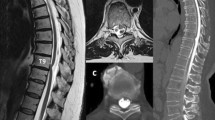Abstract
We report an unusual post-traumatic spinal cord herniation, which became symptomatic 38 years after the trauma. A 44-year-old man presented with a 2-year history of increasing impotence, neuropathic bladder dysfunction and dissociated sensory loss below the level of T6. At the age of 6 years he had a severe blunt spinal injury with transient paraparesis. MRI revealed right lateral and ventral displacement of the spinal cord at the T5/6 level. The spinal cord was surgically exposed and found to herniate through a ventral defect of the arachnoid membrane and the dura mater. As there were no other events that could have precipitated spinal cord herniation the reported blunt trauma in childhood is the most likely cause for the spinal cord herniation in this patient.
Similar content being viewed by others
References
Burres KP, Conley FK (1978) Progressive neurological dysfunction secondary to postoperative cervical pseudomeningocele in a C4-quadriplegic. J Neurosurg 48:289–291
Cobb C, Ehni G (1973) Herniation of the spinal cord into an iatrogenic meningocele. J Neurosurg 39:533–536
Dunn V, Smoker WR, Menezes AH (1987) Transdural herniation of the cervical spinal cord as a complication of a broken fracture-fixation wire. AJNR 8:724–726
Goodmann SJ, Gregorius FK (1974) Cervical pseudomeningocele after laminectomy as a cause of progressive myelopathy. Bull L A Neurol Soc 39:121–127
Mizunu J, Nakagawa H, Itawa K (1986) Postoperative spinal cord herniation diagnosed by metrizamide. CT Neurol Surg (Tokyo) 14:681–685
Sachdev VP, Huang YP, Shah CP, Mallis LI (1981) Posttraumatic pseudomeningocele (enlarging fracture?) in a vertebral body. J Neurosurg 54:545–549
Wortzman G, Tasker RR, Rewcastle NB, Richardson JC, Pearson FG (1974) Spontaneous incarcerated herniation of the spinal cord into a vertebral body. J Neurosurg 41:631–635
Isu T, Iizuka T, Iwasaki Y, Nagashima M, Akino M, Abe H (1991) Spinal cord herniation associated with an intradural spinal arachnoid cyst diagnosed by magnetic resonance imaging. Neurosurgery 29:137–139
Masuzawa H (1992) Hernia of the spinal cord. Case report and review of the literature. Neurosurgery 30:969–970
Oe T, Hoshino Y, Kurokawa T (1990) A case of idiopathic herniation of the spinal cord associated with duplicated dura mater and with an arachnoid cyst. Jpn Orthop Assoc 64:43–49
Tronnier VM, Steinmetz A, Albert FK, Scharf J, Kunze S (1991) Hernia of the spinal cord: case report and review of the literature. Neurosurgery 29:916–919
Burke DC (1976) Injuries to the spinal cord in children. In: Vinken PJ, Bruyn GW (eds) Handbook of clinical neurology, vol 25 North Holland, Amsterdam, pp 175–195
Author information
Authors and Affiliations
Rights and permissions
About this article
Cite this article
Urbach, H., Kaden, B., Pechstein, U. et al. Herniation of the spinal cord 38 years after childhood trauma. Neuroradiology 38, 157–158 (1996). https://doi.org/10.1007/BF00604806
Received:
Accepted:
Issue Date:
DOI: https://doi.org/10.1007/BF00604806




